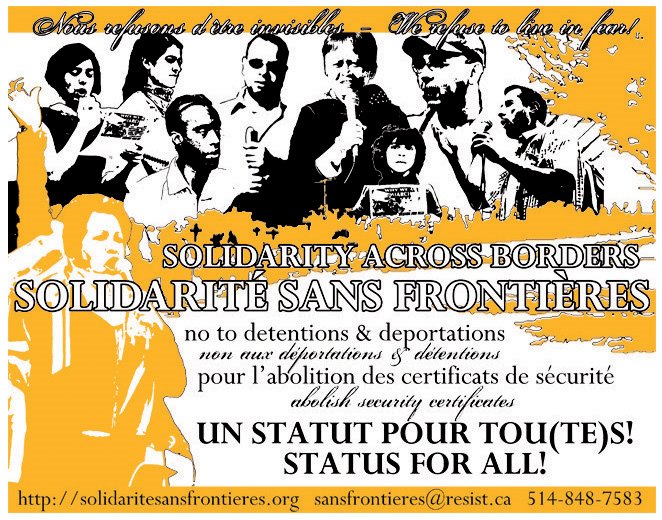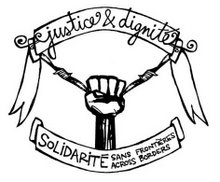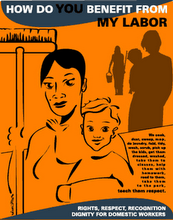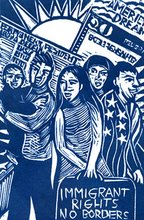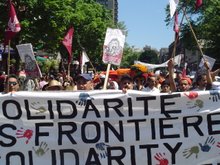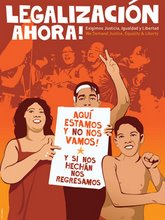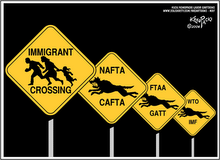
![]()
by Sue Collis
August 22, 2007
On Friday, August 10, 2007 my husband, Shawn Brant, was denied bail for the second time on charges relating to the closure of the CN main line, a provincial highway and the 401. Shawn is a member of the Mohawk Nation, from the community of Tyendinaga. The larger context for the charges he currently faces include unresolved land claims, poverty, suicides and polluted water throughout First Nations communities across Canada.
It would certainly be nice if, by 2007, the Canadian justice system had become a bastion of tolerance, devoid of bias. Unfortunately, what I saw on August 10th was a few isolated snippets from newspaper reports being treated as determining factors in whether another First Nations person was locked up or returned to his family.
As I drove home, I found myself contemplating the best way to tell my children that they would have to wait an unknown period of time before seeing their dad, and wondering how to explain (to a seven and five-year-old) why this was the case.
As the reality of our severed family hit me, I reminded myself how much worse it is for the thousands of families in First Nations communities who lose their babies to CAS (the Children's Aid Society) because they don’t have enough money to feed them. Or for the mothers who bathe their babies in water that is just as likely to make them sick as it is to clean them. Or for the families who face the horrible grief of burying their children after they decide to take their own lives rather than live on without hope for anything better.
And thinking about that, I was of course reminded about why Shawn is in jail to begin with: because the Canadian government recognizes that my husband is a person who can put a voice to that suffering. Shawn has been at the forefront of a process of carving out a national platform that exposed Canada's dismal and embarrassing record towards First Nations peoples. For perhaps the first time, an environment was being created where Canadians at large cared whether First Nations children lived or died.
In trying to understand how bunk 18, dorm 4 of the Quinte Detention Centre has become my husband's home, I have had the opportunity to reflect on how this all began.
It was shortly after the election of Mike Harris in Ontario in 1995: Dudley George lay dead and the infamous 21.6 per cent welfare cut had been imposed. While severe to everyone on fixed income it was particularly devastating to First Nations communities. In the absence of economic opportunities, compounded with geographical isolation and the still very prevalent impact of residential school abuses, the cut to welfare was crushing. But there was hope.
Organized labour rallied and kicked off a campaign of rotating economic disruptions. It was a plan designed to target government and private industry, starting small and escalating over time unless the government met the movement's demands. “We can't have passive resistance,” said Sid Ryan, president of the Ontario division of the Canadian Union of Public Employees. “We have to send a strong message to Mike Harris and the business community that if they want to change the social network it's going to be one hell of a fight.” “The safety of kids is at issue,” Ryan said. “The transportation is going to be shut down, likewise GO trains . . . There's going to be chaos in the highways.”
Starting in places like London and Kitchener Waterloo, infrastructure was targeted and the cities systematically shut down. In October 1996, labour converged in Toronto and in one massive show of solidarity some 300 businesses, government buildings and services were completely shut down.
The Toronto Transit Commission, which normally carried two million riders daily, was completely stationary. The Canada Post facility responsible for sorting 50 per cent of the country's mail was shut. Pearson International Airport cancelled numerous flights as passengers rearranged their schedules to avoid the chaos of the day. The Canadian Auto Workers disrupted the airport's cargo terminal for five hours. Libraries were closed, marriage licences unavailable and garbage pick-up cancelled. Essentially all municipal services were either shut down or curtailed. Hospitals across Toronto cancelled all non-essential surgery and rescheduled chemotherapy sessions.
In short, the single largest municipality in the country came to a grinding halt. Millions of dollars were lost to the economy province-wide. United Steelworkers representative Carolyn Egan described the day as, “…only one battle. We haven’t won the war.” And Ryan warned at the time, “If we don't see the language, if we don't see the promised changes...in 48 hours, we'll be calling a province-wide strike.”
A decade later, in November 2006, the Mohawk community of Tyendinaga—in response to unresolved land claims, polluted drinking water, overwhelming poverty and suicides in all First Nations communities—launched a campaign similar to those days of action. It announced a plan of rotating economic disruption. The campaign started with road closures and business disruptions.
In March, a quarry on Mohawk land was taken over and permanently closed. On April 20 the CN main line was closed for 30 hours and on June 29, the CN main line, highway 2 and Highway 401 were simultaneously targeted and closed for a 24-hour period. And the message resonated. In the lead up and wake of June 29, Aboriginal issues enjoyed enormous support from the Canadian public with Angus Reid showing 71 per cent of Canadians wanting actions on land claims and 41 per cent of Ontarians prepared to acknowledge rail blockades as justified given the current landscape.
It is worth noting the reactions to these two very similar campaigns. The economic repercussions of the labour movement's rotating and escalating city shut-downs far surpassed those on June 29, and yet no labour leader was ever jailed, let alone charged. I am left to wonder at the difference in the government's response. The message appears to be if you are Indian, somehow your grievances do not warrant the same respect or attention. You are to suffer in silence.
As lawyer Howard Morton said at Shawn's bail review, “There is not a right that exists in this country that was not achieved through varying degrees of struggle and civil unrest.”
If in the year 2007, Shawn is to sit in jail for forcing attention to the national crisis that the subhuman conditions throughout First Nations communities have become, when literally centuries of following the “appropriate channels” of redress have utterly failed, then so be it.
Locking up Aboriginal people who are not prepared to ignore the atrocities of the state or suffer silently is certainly not without precedent in this country. In 1924 the Canadian government employed the military to kill one Mohawk traditional Chief in an effort to break the Iroquois Confederacy and bring the Mohawks under the control of the current Indian Act Band Council system. Many other Chiefs were imprisoned for a total of seven seasons without valid charges. My husband is just completing the end of his first season behind bars and says: “I should sit with pride and honour sit for six more to equal the sacrifice my ancestors made for us, so that we might have a chance to exist.”
The June 29 events inspired pride and hope across Indian country. Perhaps that is what the government considers most dangerous.
Sue Collis is the wife of Shawn Brant, and mother of two children. She lives in Tyendinaga, Mohawk Territory.
http://www.rabble.ca/in_her_own_words.shtml?sh_itm=63e6719638099df2069905bd6c53e96f&rXn=1&
